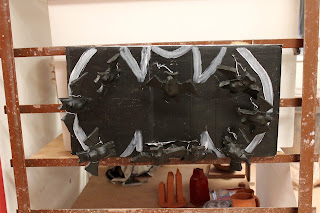The final project, the hanging installation project, is worth 25% of your grade (or 25 points). To make things transparent, I have put how I am grading your projects below. There are four sections of which I am grading, if you think of your project in terms of percentage, then each section is worth 25% of your project. Each section has parameters and the max you can get in each section is 6.25 which four times is 25 points (or 100%), scoring high in on section will not preclude you from scoring low on another.
REMINDER - All of your assignments were broken down into a points system based on the percentage of your grade it was to make it easier to calculate your grade yourself.
ELEMENTS OF DESIGN: TEXTURE, COLOR, SHAPE/FORM, SPACE
PRINCIPLES OF DESIGN: REPETITION, BALANCE, EMPHASIS, CONTRAST, UNITY
6.25: Planned carefully, made several sketches, and showed an awareness of the elements and principles of design; chose color scheme carefully, used space effectively.
5: The artwork shows that the student applied the principles of design learned in class while using one or more elements effectively; it is evident that space was considered.
3.75: The student did the assignment adequately, yet it shows lack of planning and little evidence that an overall composition was planned.
2.5: The assignment was completed and made, but showed little evidence of any understanding of the elements and principles of art; no evidence of planning. Ex: works not fired/painted/finished, rough edges.
1.25: The student did the minimum or the artwork was never completed. If the work is not hanging, even if it is designed to hang, this is the score you will receive.
Creativity/Originality
6.25: The student explored several choices before selecting one; generating many ideas; tried unusual combinations or changes on several ideas; made connections to previous knowledge; demonstrated understanding problem solving skills.
5: The student tried a few ideas for selecting one; or based his or her work on someone else's idea; made decisions after referring to one source; solve the problem in a logical way.
3.75: The student tried an idea, and completed the assignment adequately, but it lacked originality; fast, sloppy works that were the easiest, most obvious choice.
2.5: The student fulfilled the assignment, but gave no evidence of trying anything meaningful and challenging to them.
1.25: The student showed no evidence of original thought.
Effort/Perseverance
6.25: The project was continued until it was as complete as the student could make it; gave effort far beyond that required; takes pride in going well beyond the requirement. Came to open studios to complete work.
5: The student worked hard and completed the project, but primarily within the constraints of classroom time; with a little more effort it might have been outstanding.
3.75: The student finished the project, but it could have been improved with more effort; adequate interpretation of the assignment, but lacking finish; chose an easy project and did it indifferently.
2.5: The project was completed with minimum effort.
1.25: The student did not finished the work adequately.
Craftsmanship/Skill/Consistency
6.25: The artwork was carefully and patiently done; it is as good as the students skill level allows.
5: With a little more effort, the work could have been outstanding; lacks the finishing touches, looks rushed, rough, cracking.
3.75: The student showed average craftsmanship; adequate, but not as good as it could have been, a bit careless.
2.5: The student showed below average craftsmanship, lack of pride in finished work.
1.25: The student showed poor craftsmanship; evidence of not taking the project seriously and putting in the time and effort to complete it properly.




























